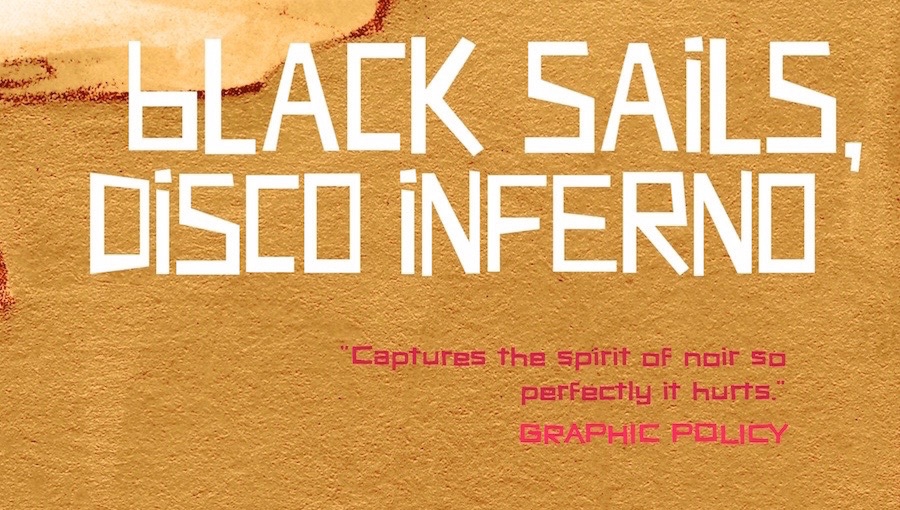Recently, Andrez Bergen finished a comic series called Trista & Holt: a genderbent retelling of the story of Tristan and Iseult, told in classic noir style and set in the disco era. I had the pleasure of reviewing the comic and highly recommend it. Now, Bergen has adapted that story into a novel called Black Sails: Disco Inferno. It’s the same story, told in a different way, but the effect is a very different one. Even at the places where I knew what was going to happen, I still found it a thrill to read.
The story begins with a bomb which kills two members of the Cornwall crime family. A clear act of war, it’s now up to Trista Rivalen to track down who’s responsible on behalf of her aunt, Marcella “Queenie” Cornwall, head of the Cornwall criminal empire. The finger is soon pointed at the Holt criminal empire, and so begins a game of cat and mouse, murder and retribution, back and forth between the two families.
The Holts are led by Isidor “Anguish” Holt. His son, Issy Jr., is a rich playboy who spends most of his time at the Disco Inferno nightclub, seemingly without a care in the world. Of course, looks can be deceiving, and Issy is, in fact, much smarter and more capable than most people give him credit for.
Eventually, Issy and Trista are destined to meet and fall in love. And, of course, their love is doomed, because their families are at war. There are echoes of Romeo and Juliet, Lancelot and Guinevere, and plenty of other classic star-crossed love stories. It’s important to remember, though, that Tristan and Iseult predate them all.
A common theme throughout my reviews of the comic was that I’d never actually read Tristan and Iseult and had only a vague idea of how this ’70s disco noir compared to the source material. I concluded that a knowledge of the original wasn’t necessary to the enjoyment of the story; however, as I read the novel, I finally did a bit of research into the original story and found a lot of parallels that I had missed before. Characters and events that seem like throwaways actually have a place in the original. I still maintain that you can enjoy both the comic and the novel without knowing anything about Tristan and Iseult, but the more familiar you are with the source, the better you’ll understand just how cleverly this new version is told.
Novels are a very different medium from comics, and Bergen has proven that he’s a master of both. Comics are told in pictures which, it is said, are worth a thousand words. The art in the Trista & Holt comic speaks volumes, conveying significant information at a glance, often with no words at all. In the novel, however, we need descriptions. Whereas the comic perfectly captured the visual noir style, with Bergen’s signature photo art, the novel captures the hard-boiled prose. As a result, the prose descriptions often convey the same scenes as the comic’s artwork, but in a different way, lending us a different perspective on things. Sometimes ,they convey MORE detail than the comic art did. And, sometimes, they take us in a different direction entirely.
That’s the important thing to remember: it’s the same story, but it’s not told the same way. As such, some different things happen, and not everything turns out the same. Then again, even the original Tristan and Iseult story has several different versions to choose from.
I realize that most of my review has been about comparing the novel with the comic; however, even if you didn’t read the comic at all, the novel is still great and worth checking out, all on its own. Likewise, the comic is great and worth checking out, even if you don’t read the novel; however, it really is better to read both. Like almost all of Bergen’s other works, they function perfectly well as standalone stories; however, by reading them both, you get so much more. They shed light on one another and enhance one another, adding to both your enjoyment and appreciation of both. And, I imagine, if you read Tristan and Iseult as well, you’ll enhance your enjoyment and appreciation even further. For now, though, start with the novel and go from there. You won’t be disappointed.

